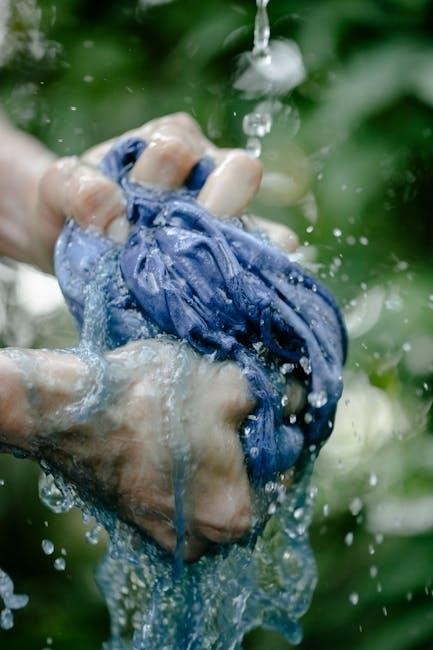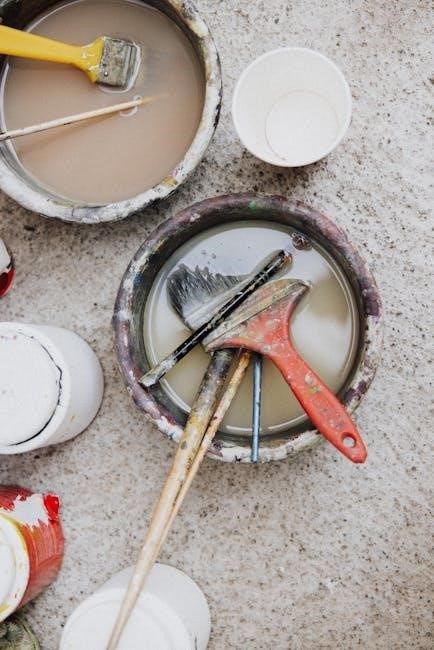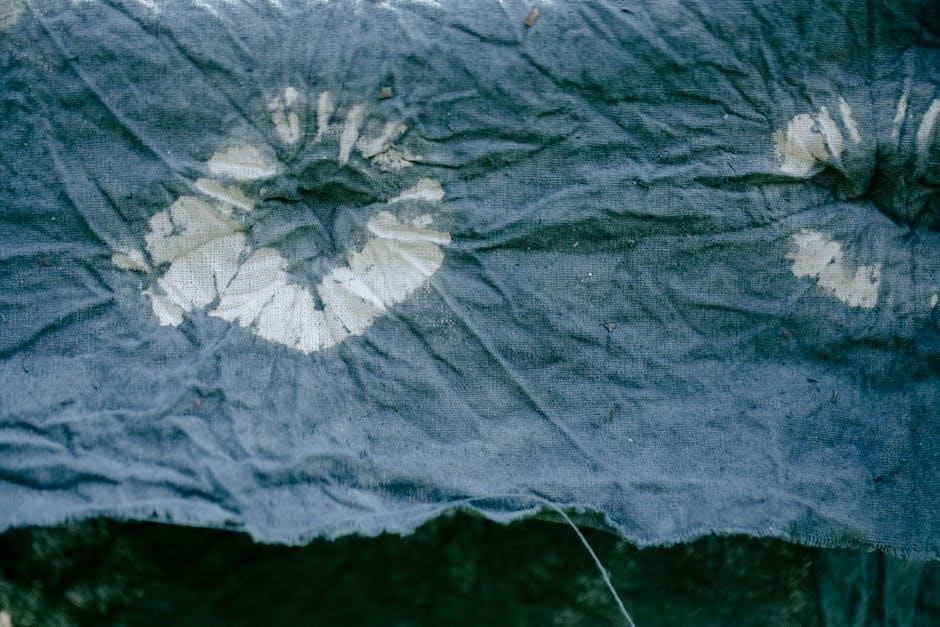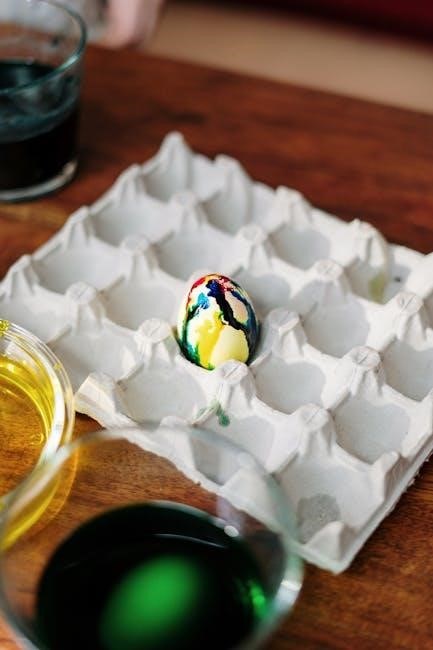Tulip Tie Dye Washing Instructions: A Comprehensive Guide

Achieving vibrant, long-lasting colors in your tie-dye projects requires proper washing techniques. This comprehensive guide provides step-by-step instructions for washing your Tulip tie-dye creations, ensuring optimal colorfastness. Learn how to pre-treat, rinse, choose detergents, and set washing machine settings for lasting results.
Overview of Tulip Tie Dye Kits
Tulip tie dye kits are popular choices for creating vibrant, colorful designs on fabrics. Known for their ease of use and one-step dye process, these kits eliminate the need for pre-soaking fabrics in soda ash, simplifying the tie-dye process. The kits come in various sizes and color assortments, catering to different project needs and preferences.
Each Tulip tie dye kit typically includes pre-filled bottles with dye powder, rubber bands, gloves, and an instruction guide. The dyes are designed to be permanent and colorfast, ensuring that the vibrant colors last wash after wash. However, it’s essential to follow proper washing instructions to maintain the color intensity and prevent bleeding.
Tulip offers a variety of kits, from single-color options to large kits with multiple colors, allowing for a wide range of creative possibilities. Some kits also include technique guides with tips and inspiration for creating unique tie-dye patterns. Whether you’re a beginner or an experienced tie-dye artist, Tulip kits provide a convenient and reliable way to achieve stunning results.
Understanding the components of a Tulip tie dye kit and the recommended usage guidelines is crucial for successful tie-dye projects. The next sections will delve into the essential setting time and the initial rinse process, which are critical steps before washing your tie-dyed creations.
Essential Setting Time for Vibrant Colors
After applying the dye from your Tulip tie dye kit, allowing sufficient setting time is crucial for achieving vibrant and long-lasting colors. The general recommendation is to let the dye set for at least 6 to 8 hours, or even longer for more intense and saturated hues. This extended setting period allows the dye molecules to fully bond with the fabric fibers, ensuring better color retention during subsequent washing.
During the setting time, it’s important to keep the tie-dyed item in a warm and humid environment. This can be achieved by placing the item in a plastic bag or wrapping it in plastic wrap. The warmth and moisture help to facilitate the dye absorption process, resulting in brighter and more vibrant colors.
While the minimum recommended setting time is 6 to 8 hours, some tie-dye enthusiasts prefer to let their projects set for as long as 24 hours. This extended setting time can lead to even more intense and long-lasting colors, especially when using darker or more concentrated dyes. Experimenting with different setting times can help you discover the optimal duration for your specific dye colors and fabric types.
Once the setting time is complete, the next step is to rinse the tie-dyed item thoroughly to remove any excess dye. This initial rinse is an essential step in preventing color bleeding during the first wash. The following section will provide detailed instructions on how to perform the initial rinse effectively.

Initial Rinse: Removing Excess Dye
After the dye has set for the recommended time, the initial rinse is a critical step in removing excess dye and preventing unwanted color bleeding during the first wash. This process helps to ensure that the vibrant colors of your tie-dye design remain intact and don’t transfer to other parts of the fabric or other garments in the wash.
Begin the initial rinse by wearing gloves to protect your hands from any residual dye. Carefully remove the rubber bands or ties that were used to create the tie-dye pattern. Once the ties are removed, hold the fabric under cool or cold running water. Start by gently squeezing and manipulating the fabric to release the excess dye. Continue rinsing until the water runs clear or nearly clear.
It’s important to avoid using hot water during the initial rinse, as hot water can cause the dye to bleed more easily. Cold water helps to keep the dye molecules from loosening and transferring to other areas of the fabric. Be patient and thorough during this process, as a well-executed initial rinse will significantly reduce the risk of color bleeding in subsequent washes.
Once the initial rinse is complete, gently squeeze out any excess water from the fabric. Avoid wringing or twisting the fabric, as this can distort the tie-dye pattern. After the initial rinse, proceed to the first wash, following the guidelines outlined in the next section.
The First Wash: A Crucial Step
The first wash after tie-dyeing is a pivotal moment in setting the colors and preventing future bleeding. This wash helps remove any remaining loose dye particles and ensures the design’s longevity. To start, turn your tie-dyed item inside out to protect the vibrant colors during the washing process. This reduces direct friction on the dyed surface, minimizing fading.
Load the washing machine with only the tie-dyed item, or with other tie-dyed items of similar colors. This prevents any potential color transfer to other garments. Add a small amount of mild detergent specifically designed for delicate fabrics or colors. Avoid using detergents with bleach or brighteners, as these can fade or alter the tie-dye colors.
Set the washing machine to a cold-water cycle. Cold water is essential for the first wash as it helps to prevent further dye bleeding. Hot water can cause the dye molecules to loosen and run, resulting in a faded or muddy appearance. Choose a gentle or delicate cycle to minimize agitation, which can also contribute to color loss.
Once the wash cycle is complete, promptly remove the tie-dyed item from the washing machine. Avoid leaving it in the machine for an extended period, as this can increase the risk of color bleeding. Proceed to the drying stage, following the recommended drying methods for tie-dyed fabrics.
Washing Machine Settings: Cold Water is Key

When washing tie-dyed items, especially those created with Tulip dyes, the washing machine settings play a crucial role in preserving the vibrancy and preventing color bleeding. Among these settings, water temperature stands out as the most important factor. Always opt for cold water when washing tie-dye.
Cold water minimizes dye bleeding, which is essential for maintaining distinct patterns and preventing colors from running into one another. Hot water can cause the dye molecules to loosen and escape from the fabric, leading to a faded or muddied appearance. By using cold water, you help the dye molecules stay anchored within the fabric fibers.
In addition to water temperature, selecting the appropriate wash cycle is also important. Choose a gentle or delicate cycle to reduce agitation, which can contribute to color loss. A gentle cycle minimizes friction between the fabric and the washing machine drum, helping to prevent the dye from wearing away.
Furthermore, avoid overloading the washing machine. Overcrowding can increase friction and agitation, potentially leading to more dye loss. Wash tie-dyed items separately or with a small load of similar colors to ensure adequate space for the items to move freely in the water. Following these guidelines will help preserve the quality and vibrancy of your tie-dyed creations.
Detergent Choice: Mild is Best
Selecting the right detergent is crucial when washing tie-dyed fabrics, particularly those dyed with Tulip kits. Harsh detergents can strip the color and cause fading, so a mild detergent is always the best option. Look for detergents labeled as gentle, color-safe, or designed for delicate fabrics.
These detergents are formulated to clean effectively without being overly aggressive, helping to preserve the vibrancy of your tie-dye patterns. Avoid detergents that contain bleach or brighteners, as these can significantly fade the colors and alter the design of your tie-dyed items.
When using a mild detergent, it’s also important to use the correct amount. Too much detergent can leave residue on the fabric, which can dull the colors and attract dirt. Follow the detergent manufacturer’s instructions carefully, and consider using a slightly smaller amount than recommended, especially for delicate fabrics.
Furthermore, consider using a pH-neutral detergent. These detergents are designed to be gentle on fabrics and dyes, helping to maintain the color and integrity of your tie-dyed creations. By choosing a mild, color-safe, and pH-neutral detergent, you can ensure that your tie-dye projects remain vibrant and beautiful for years to come. Remember, gentle care is key to preserving the unique artistry of your tie-dye.
Washing Tie Dye Separately: Preventing Color Bleeding
One of the most important rules when washing tie-dye for the first time (and even subsequent washes) is to wash it separately from other clothes; This is because tie-dye, especially when freshly dyed, tends to bleed excess dye during the washing process. If you wash it with other garments, the loose dye can transfer onto them, staining them with unwanted colors.
To avoid this, always wash your tie-dyed items by themselves or with other tie-dyed items of similar colors. For example, if you have a shirt with blues and purples, wash it with other blue and purple tie-dyed items, but not with items that are white or light-colored. This will minimize the risk of color bleeding and ensure that your other clothes remain pristine.
For the very first wash, it’s a good idea to even wash the tie-dyed item completely alone. This is when the most dye is likely to bleed, and it’s better to be safe than sorry. If you’re particularly concerned about color bleeding, you can also add a color catcher sheet to the wash. These sheets are designed to absorb loose dye and prevent it from transferring onto other fabrics.
Remember, preventing color bleeding is essential for maintaining the vibrancy and beauty of your tie-dye designs. By washing tie-dyed items separately, you can protect your other clothes and ensure that your tie-dye creations remain colorful and unique.
Drying: Air Drying Recommended Initially
After washing your newly tie-dyed garment, the next crucial step is drying. While a machine dryer might seem like the quickest option, air drying is highly recommended, especially for the first few drying cycles. This is because the heat from a dryer can cause the dye to fade or bleed, potentially diminishing the vibrancy of your design. Additionally, the tumbling action can further agitate any loose dye, increasing the risk of unwanted color transfer.
To air dry your tie-dye, gently remove it from the washing machine and give it a good shake to remove excess water. Then, hang it on a clothesline or drying rack, preferably in a shaded area to avoid direct sunlight, which can also contribute to fading. Ensure the garment is well-ventilated to facilitate faster drying and prevent mildew growth.
If you must use a dryer, especially after the initial air drying phases, use the lowest heat setting possible. High heat can damage the fabric and accelerate fading. It’s also wise to check the garment frequently during the drying cycle to monitor for any signs of bleeding. If you notice dye transfer, remove the item immediately and revert to air drying.
Air drying not only helps preserve the colors of your tie-dye but is also gentler on the fabric, extending the life of your garment. Embrace this method, especially when your tie-dye is new, to keep your designs looking their best.
Subsequent Washing: Continuing with Care
After the initial wash and dry, maintaining the vibrancy of your tie-dye creations requires ongoing care during subsequent washings. While the risk of significant dye bleeding diminishes after the first few washes, it’s still essential to treat your tie-dye garments with consideration to preserve their colors and prevent any unwanted fading or color transfer.
Continue washing your tie-dye items separately or with similar colors for several washes. This precaution helps prevent any lingering dye from affecting other clothing. Always use cold water, as hot water can cause the dyes to loosen and fade over time. A mild detergent is still the best choice; avoid harsh chemicals or bleach, which can strip the color from the fabric.
Consider turning your tie-dye garment inside out before washing. This reduces the direct friction on the dyed surface, minimizing wear and tear and helping to maintain the color’s intensity. If you notice any slight color bleeding during washing, don’t be alarmed; it’s normal for a small amount of dye to release, especially in the first few washes.
When drying, continue to air dry whenever possible. If using a dryer, keep the heat low and remove the garment promptly to prevent over-drying, which can also lead to fading. By adhering to these practices, you can ensure your tie-dye creations remain vibrant and eye-catching for a long time.
Avoiding Fabric Softener and Dryer Sheets
When caring for your tie-dye creations, it’s crucial to avoid using fabric softener and dryer sheets. These products can negatively impact the dye’s adherence to the fabric, leading to premature fading and a reduction in the vibrancy of your designs.

Fabric softeners contain chemicals that coat the fibers of the fabric, making them feel softer. However, this coating can interfere with the dye’s ability to bond effectively, causing the colors to appear dull and wash out more quickly. Similarly, dryer sheets release softening agents that can have the same detrimental effect on tie-dye.
Moreover, both fabric softeners and dryer sheets can leave a residue on the fabric, which can attract dirt and grime, further dulling the colors of your tie-dye. They can also reduce the absorbency of the fabric, which is especially problematic for items like towels or washcloths.
To maintain the vibrancy and longevity of your tie-dye, simply skip the fabric softener and dryer sheets altogether. Instead, consider using dryer balls, which help to soften fabrics naturally without the use of chemicals. Alternatively, you can add a cup of white vinegar to the rinse cycle as a natural fabric softener. By avoiding these products, you’ll ensure that your tie-dye creations remain vibrant and beautiful for years to come.
Dealing with Potential Color Bleeding
Despite your best efforts, some color bleeding may occur, especially during the initial washes. To minimize the risk of staining other garments, always wash your tie-dyed items separately, or with other similarly colored tie-dyed items.
If you notice color bleeding during the initial rinse, don’t panic. Immediately re-rinse the item in cold water until the water runs clear. You can also add a cup of white vinegar to the rinse water, as vinegar helps to set the dye and prevent further bleeding.
For the first few washes, it’s wise to keep a close eye on your tie-dyed items. If you’re washing them in a machine, check the water periodically to see if any color is being released. If you notice significant bleeding, remove the item immediately and rinse it again.
To test for colorfastness, you can also try washing the item with a white cloth. If the cloth picks up any dye, it indicates that the item is still bleeding and should be washed separately until the bleeding stops. With patience and care, you can successfully manage color bleeding and enjoy your vibrant tie-dye creations without worry.
Tips for Maintaining Colorfastness
Maintaining the vibrancy of your tie-dye creations involves consistent care and attention to detail. One of the most crucial tips is to always wash your tie-dyed items inside out. This simple act helps to protect the dyed surface from direct friction during the wash cycle, reducing fading and wear.
Consider using a color-safe detergent specifically designed to protect dyed fabrics. These detergents often contain ingredients that help to lock in the color and prevent bleeding. Avoid detergents with harsh chemicals or bleaching agents, as these can strip the color from your tie-dye items.
When possible, hand-wash your tie-dye creations, especially delicate items. Hand-washing is gentler on the fabric and helps to preserve the color for longer. If you prefer to use a washing machine, opt for a delicate cycle with a slow spin speed.
Proper storage can also play a role in maintaining colorfastness. Store your tie-dyed items in a cool, dark place away from direct sunlight. Sunlight can cause the colors to fade over time. By following these tips, you can ensure that your tie-dye creations remain vibrant and beautiful for years to come.
